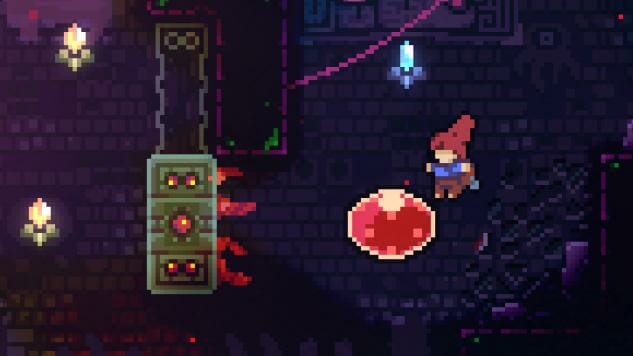
The mountain is a metaphor.
At first Celeste seems like the latest in a long line of arty, 8- and 16-bit platformer pastiches, the next Braid or Super Meat Boy or VVVVVV. And guess what: it is. First appearances aren’t really deceiving this time. The art recalls the early ‘90s and the precision required to navigate these levels comes straight out of the heyday of platforming, and if that’s what you most liked about those games you’ll probably like this one, too.
There’s a little bit more than nostalgia going on here, though. Matt Thorson’s follow-up to Towerfall (with programming by Noel Berry) employs a familiar aesthetic and language from videogames past to tell a story about mental health and self-actualization, using the mountain the game is named after as a (maybe too obvious) representation of a young woman’s struggles with depression and self-doubt. Avoiding Meat Boy’s single-minded focus on impeccable skills, or the mawkish, self-impressed metacommentary of Braid, Celeste inextricably ties its difficulty to its message, striving for a depth rarely seen in even the more recent examples of the genre.
It’s a little awkward in its execution. Calling it clumsy would be too much—plus clumsiness is the ultimate death knell in such an exactingly tough platformer—but Celeste definitely works better as a game than as a thought-provoking exploration of mental illness. That central metaphor of the mountain is not subtle in the least, and although literally trying to outrun your inner demons perfectly translates that struggle to a videogame setting, it also reduces deep, intractable problems into a recognizable and highly tractable recipe of button mashing. The writing in the cut-scenes can be nicely nuanced, and each character’s dialogue reveals a distinctive, well-defined voice, but it all eventually returns to wall-jumping and pinpoint accuracy that makes Mega Man 2 look forgiving.

That said, we’re not here to bury Celeste. The constantly evolving suite of tools provided to the player presents some of the most satisfying—and satisfyingly frustrating—videogame action in recent memory. Your character, Madeline, has a few basic abilities: she can jump, duck, hold onto walls and climb them until her strength gives out (there’s no on-screen meter for that, but she will start to blink red when she’s about to overtax herself and lose her grip). She also has a dash maneuver that lets her burst forth in whatever direction the thumbstick or d-pad is pressed, but only once at a time, until she regains solid footing. Each level introduces different environmental gimmicks with unique properties that, when strung together with Madeline’s moves, will help you maneuver through various platforming puzzles. Floating globules act as launching pads, green crystals will restore Madeline’s ability to dash, certain platforms will only move when a dash is performed, and various other tricks have to be figured out throughout the mountain’s various levels. You’ll regularly be expected to chain them all together with perfect timing and positioning.
With Celeste Thorson has mastered level design as an unambiguous challenge. Because motion in the game is defined by clear-cut rules, you’ll usually see exactly what you’re expected to do to succeed when you stumble into a new room. (The exceptions are when you discover a new gimmick for the first time and have to learn what it does, or when you encounter one of the areas that are too big to fit onto a single screen.) The trick is being able to physically perform what you know you have to do. It isn’t easy. You’ll jam the stick in one direction, hit a button to jump, hold down another button to climb a wall, have a fraction of a second to tap a third button to dash at an angle and hit an object moving back and forth in midair at the exact right spot, and then string together another four or five (or eight, or 10) commands before reaching safe ground and rushing into the next room. You will most likely die often, immediately repeating the same rooms over and over until you finally nail every jump and dash and make it to the other side. Celeste taunts you, letting you see what needs to be done and then throwing all manner of complications in your path, from deadly spikes to dissolving platforms to strong winds that will blow you off course. And if you’re a completionist, you can collect strawberries that dot the landscape, or search for well-hidden cassette tapes that open access to even more brutal “b-side” versions of each level.
When it comes to having to quickly choose from a limited number of commands with lightning speed and perfect accuracy to traverse a treacherous playfield, Celeste is an inspired triumph. The vibrant use of color and warm, stylistically varied score elevate the retro aesthetic beyond mere homage. Although the game’s story feels slightly hampered by the practical necessities of its play, it’s still a touching and occasionally insightful depiction of what it’s like to live with anxiety and depression. And the mountain, as in every work of art that has ever featured a mountain throughout the history of human expression, remains a metaphor.
Celeste was developed and published by Matt Makes Games. Our review is based on the Switch version. It is also available for PC, PlayStation 4, Xbox One and Mac.
Garrett Martin edits Paste’s comedy and games sections. He’s on Twitter @grmartin.